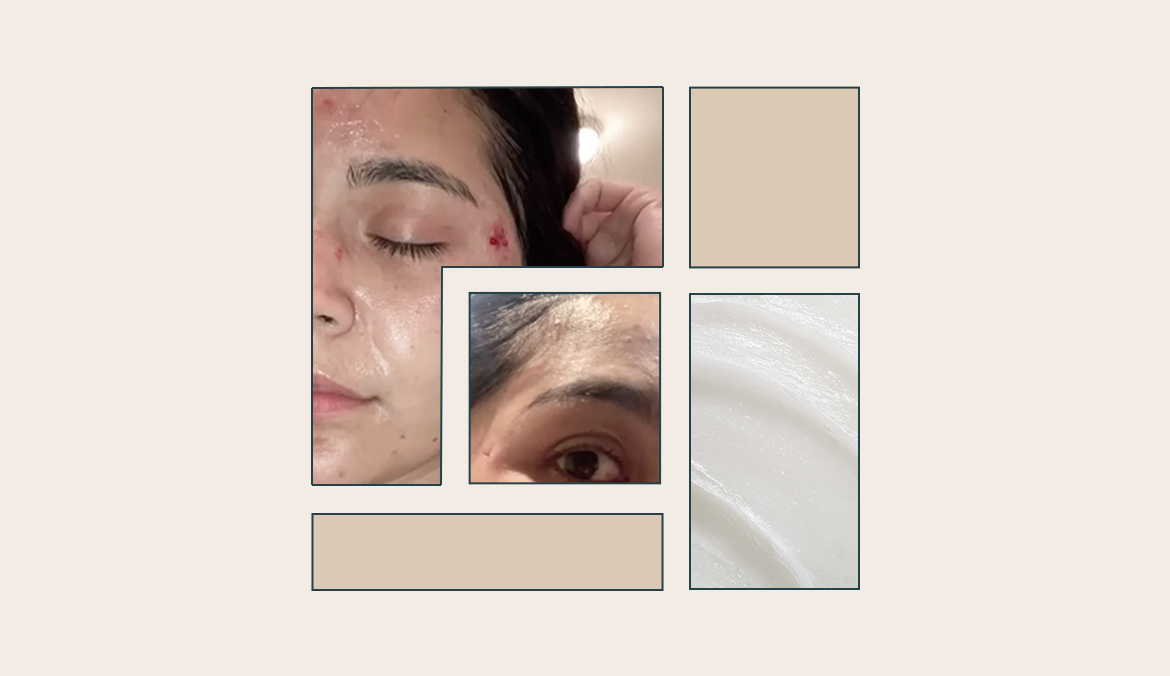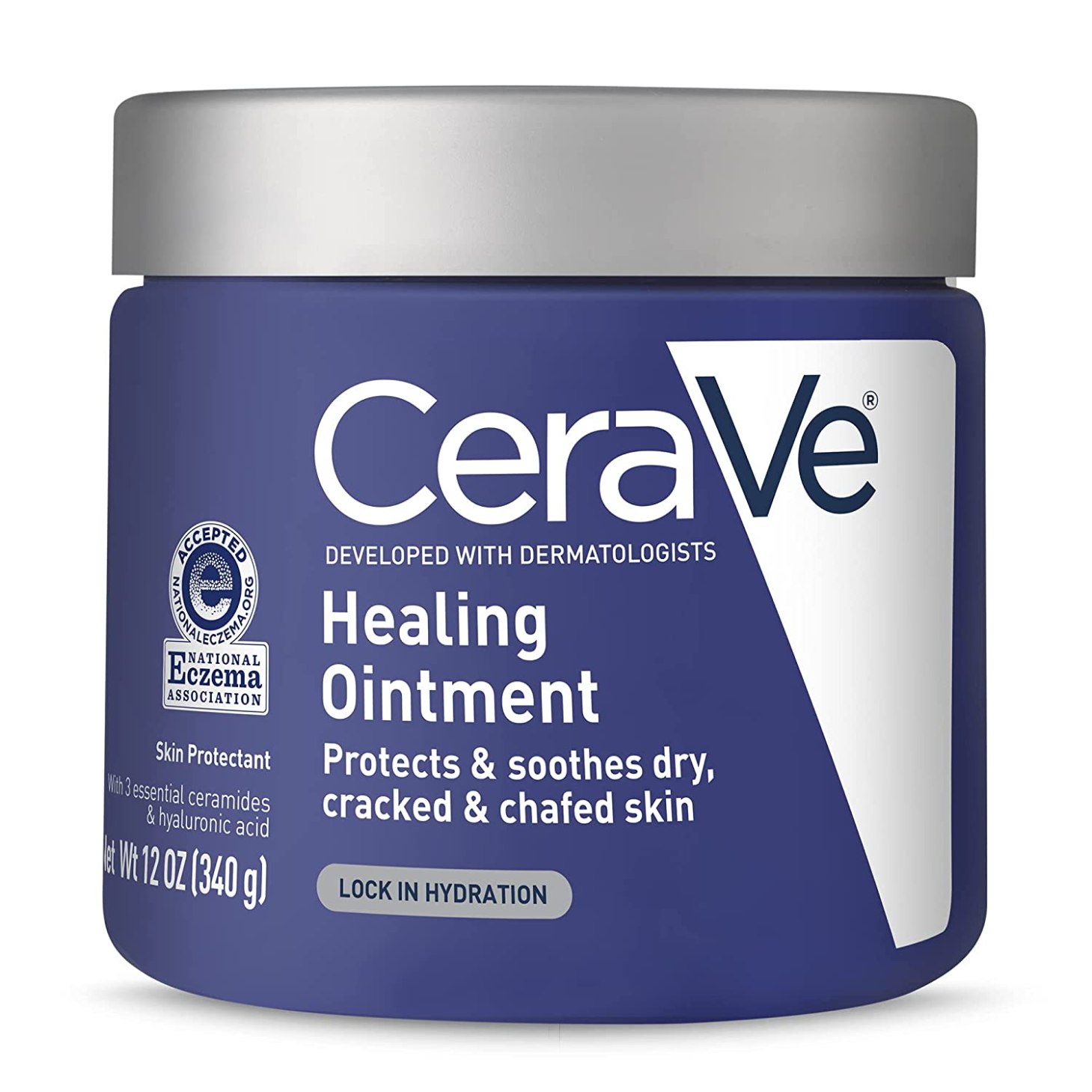In December 2020, I was trying to hang one of my plants and dropped it straight on my face. It was in a hard-plastic nursing pot, and the edge lacerated the bridge of my nose. (Yes, it drew a little blood.)
During another clumsy-girl moment, this time in April 2021, I fell while I was wearing metal frame glasses—and they punctured the side of my face as I slid face-first into a stucco wall. This time, I was even more worried that my money-maker wouldn’t heal properly because the cut was deep. (That’s the injury you see in the photo atop this story.)
I’ll always say CeraVe Healing Ointment saved me from permanent, obvious facial scarring.
Because I religiously applied the CeraVe Healing Ointment and paired it with other scar-reducing tactics (like covering it up with a bandage and applying sunscreen), both scars are now basically non-existent. While the sunscreen and bandaging definitely helped, I’ll always say it was the CeraVe Healing Ointment that saved me from permanent, noticeable facial scarring.
- Aegean H. Chan, MD, dual board-certified dermatologist and dermatopathologist
To fully understand why CeraVe Healing Ointment was a superstar at healing my scars, it’ll be helpful to understand how your skin generally heals from scars, and the ingredients actually in the product. So let’s get to it.
How your skin heals after you get injured
“When we scar, essentially, there’s some sort of trauma to the skin,” says board-certified dermatologist Aegean Chan, MD, adding that the skin will then work to repair itself by rebuilding the structure of the skin—which it does with keratin-producing cells called keratinocytes. Not only do those puppies produce keratin (a protein that makes up your skin), but they also protect your skin from any external factors that might lead to infection.
When you fall and get a small scrape, the trauma is to the epidermis—aka the top layer of skin—and the scarring is minimal, says Dr. Chan, because there’s not much skin to actually replace. In my case, though, the dermis—the lower layer of the skin—was impacted both times, which is why I experienced bleeding.
“There are no blood vessels in the epidermis—all the blood vessels are in the dermis, so if you have a significant amount of bleeding, it means you have injured the dermal layer,” says Dr. Chan. And dermal injuries have a higher risk of scarring permanently because they’re deeper wounds.
For any scar to heal optimally, says Dr. Chan, it must be moist and protected from potential infection-causing factors. And that’s where the CeraVe Healing Ointment comes in. (The photos below are a week after the injury and two mosts post-wound, respectively.)
Why CeraVe Healing Ointment promotes scar healing
“One of the most prevalent myths about healing scars is that you have to dry out wounds, that it’s good to have a scab,” Dr. Chan says. “But when you have a scab form, that actually inhibits some of that keratinocyte migration towards the center of the wound.”
When you keep your wound moist and covered while using an occlusive, which locks in moisture, you have a better shot at a non-permanent scar. That’s precisely what I did with CeraVe Healing Ointment, which ticks the occlusive box. “You can almost think of it like a Petri dish,” says Dr. Chan. “It traps in all those growth factors and creates an optimal healing environment for your skin to do the work of rebuilding that scaffolding and for your skin cells to migrate towards each other.”
CeraVe Healing Ointment creates an optimal healing environment for your skin.
CeraVe’s formula contains a few helpful scar-healing ingredients. “Petrolatum, mineral oil, and dimethicone are the three that stick out to me because those are all occlusive agents,” she says. “Again, that’s going to create a seal over your skin to allow for that optimal healing process to occur.”
For both wounds, I applied CeraVe Healing Ointment semi-regularly (in the beginning, I did it every few hours; a few months in, I did it nightly) while also keeping the scars covered with a bandage and applying SPF every two hours—because sunscreen also helps reduce scar hyperpigmentation.
“It’s important to remember that, especially if you have a deep injury, it actually takes a full year for your scar to completely mature or heal,” says Dr. Chan. That was certainly the case for me. (The photo below is present-day—about 18 months since the first injury and a little more than a year since the second.)
Another thing that’s crucial to note: Genetics and skin tone also play a role in how someone’s scars heal. “People with darker skin tones tend to scar with more hyperpigmentation,” says Dr. Chan. And other folks are genetically prone to keloiding, which is when there’s an overgrowth of scar tissue. Either way, though, slathering the ointment onto your scars can’t hurt, because you’re creating an environment that’s conducive to healing.
It’s doubtful that I’ll stop being clumsy overnight—or ever, for that matter—so best believe I’ll always keep a tub of CeraVe Healing Ointment around. I have the utmost confidence that it’ll keep working wonders for my scars.
Oh hi! You look like someone who loves free workouts, discounts for cutting-edge wellness brands, and exclusive Well+Good content. Sign up for Well+, our online community of wellness insiders, and unlock your rewards instantly.

